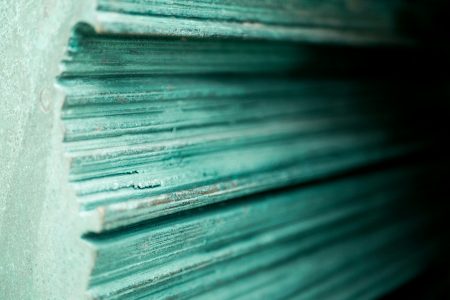Blog
Bronze patinas

As a follow up to the blog about the differences between foundry bronze and bronze resin I wanted to take a look at surface finishes with bronze and in particular patinas. I am particularly drawn to working with bronze as it offers an array of different possibilities. When polished its natural colour is a beautiful golden brown, and when patinas are applied a range of colours and textures are added to the artist’s ‘palette’. Even if a sculpture is displayed indoors, maintaining the bright natural metal look, or the coloured patina will necessitate an additional surface finish on top and this is where I want to dig a little deeper.
Why does a bronze surface need protecting?
Whilst metals such as stainless steel and aluminium are particularly resistant to corrosion the same cannot be said for others. Metals and metal alloys with any iron content will rust when exposed to water and air and when talking about bronze, whose main component is copper, exposure to moisture or the human touch will cause it to tarnish. This may be a slow process in a relatively dry indoor environment but unless kept in a vacuum, sooner or later the surface will either lose its brightness or change colour.
What exactly is a patina?
Probably the most recognisable patina on bronze is the pale green colour on the Statue of Liberty in New York Harbour. When left to the elements for some time, a green film will appear on surfaces that contain copper and this specific colour is known as Verdigris. In itself it acts as a protective barrier to further corrosion. Any maintenance that the statute has needed over the years has been where the surface has been pierced with rivets or where it meets a different material.

Verdigris patina on The Statue of Liberty
Why do patinas need protecting?
With this in mind you might ask why a sculpture that you buy from an artist would need protecting if it already has a patina, which is a protective barrier? The Verdigris on the Statue of Liberty took many years to develop a constant colour throughout and its natural formation and specific colour is already in harmony with the local eco system and therefore unlikely to change colour over time. The process of artificially creating a patina is done in a more accelerated fashion than one left outside. It is created with the use of much more aggressive/concentrated chemicals than would be found even in the harshest natural environments. In addition they are most commonly created with the use of heat. As these are no longer seen to be a perfect match to natural conditions, the likelihood of them maintaining their exact colour over time is slim. Creating the patina artificially in the studio is in itself a skill and the best way to protect the chosen colours is with a lacquer, oil, wax or French polish.
Patinas with foundry bronze and bronze resin
When the copper in bronze oxidises in a natural environment a Verdigris patina will form but the use of different chemicals on the surface will create other colours. However some chemicals will react with the metal only when a certain temperature has been achieved. With foundry bronze a blow torch can be used without melting the metal but bronze resin can’t be heated as much. As a result there is a wider selection of patina colours available when working with foundry bronze. As there are various metals used in creating the alloy, such as tin, nickel, iron, lead and aluminium, the grade of bronze used will also influence the colour. As bronze resin is a composite material made of resin and bronze powder then the percentage of metal is far lower than in foundry bronze. In addition, bronze powder is heavier than resin so it will sink and therefore to some degree, the geometry of the form itself may also affect the amount of bronze exposed at the surface. These two factors will therefore affect the intensity and regularity of the patina formed on bronze resin.


Maelstrom, with a selection of patinas and unpatinated
Conclusion
In order to maintain the shine or patina of a bronze sculpture, some sort of finish will need to be applied over the top. A foundry bronze sculpture with a brushed effect can be left without a finish, but you would have to clean and polish it yourself at some point as it naturally tarnishes. Every time you clean metal (using a product such as Brasso or Autosol metal polish) you are removing a microscopic quantity of the surface. As a bronze resin sculpture is not bronze through and through, the degree of brightness that can be achieved after each polish will decrease over time and therefore I would always recommend a finish with this composite material. Ultimately your decision of which finish you would like applied to your bespoke bronze sculpture (if any) will depend on a variety of factors. These range from the durability, transparency, ease of application and repair of the finish itself to the environment the sculpture will be exhibited in, how often it will be handled and the complexity of the form itself. If you would like to discuss commissioning a bespoke bronze sculpture and the finish it will need, then please get in touch.